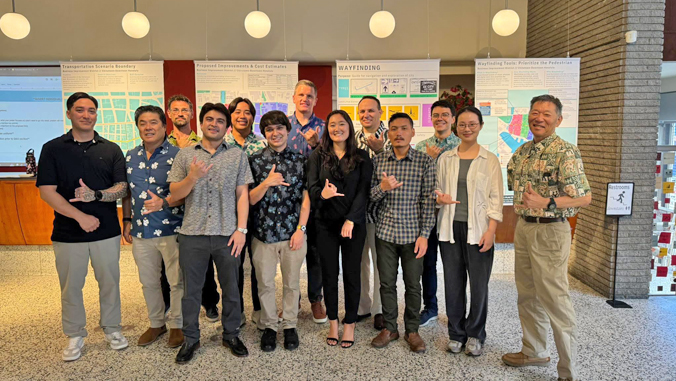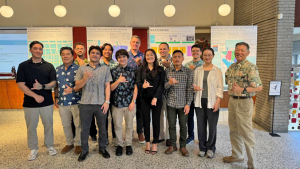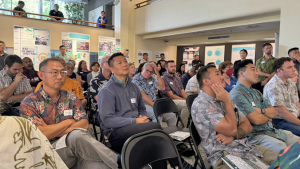

Twelve graduate students from the University of Hawaiʻi at Mānoa showcased innovative proposals to revitalize Downtown Honolulu and Chinatown through the establishment of a Business Improvement District (BID). Their work was presented on May 9, at the historic Liberty Bank Building—a mid-century modern landmark designed by popular architect Vladimir Ossipoff—in front of local planners, architects, engineers and community stakeholders.

The practicum course was led by Professor Karl Kim of the Department of Urban and Regional Planning in the College of Social Sciences; and Dean Sakamoto, a Fellow of the American Institute of Architects, professional architect and founder of Shade Institute, a non-profit community design organization. The project was also supported by UH’s National Disaster Preparedness Training Center, a congressionally-authorized center that develops and delivers training on natural hazards, coastal communities and hazard mitigation.
The team explored alternative scenarios focused on cultural identity, transportation and sustainable development in order to address safety and security, public health and urban environmental quality. UH has worked closely with the Waikīkī Business Improvement District Association, which is one of the most successful BIDs in the nation. The proposed Chinatown/Downtown BID uses coordinated public-private investment to address persistent challenges such as homelessness, crime, sanitation and commercial vacancy.

Each scenario outlined targeted strategies to improve safety, mobility, environmental resilience and economic vitality:
- The Historic and Cultural Scenario centered on strengthening community identity through preservation and cultural events.
- The Transportation Scenario aimed to increase connectivity and accessibility for pedestrians and transit users.
- The Clean City Movement Scenario promoted climate adaptation and sustainable design to support long-term urban health and safety.
The proposals address the need for enhanced services beyond what the city currently provides, such as waste management, security and beautification. This framework is designed to ensure ongoing maintenance, promote local businesses and attract both residents and visitors.
“The scenarios capture both broad directions as well as specific actions. It’s a way of taking a more messy, complex—sometimes called ‘wicked’—problems and narrowing it down into interventions with measurable improvements,” Kim said. “What’s cool about this project is that the students can track what happens. You’ll be able to see in a year, five years, 10 years—the changes and evolution that’s occurred.”
“This course was an amazing opportunity to participate in a real world planning project that was in a safe and supervised environment that was rooted in educating students,” student Kylie Yonamine said. “This experience has taught me many useful skills that I will utilize in my future professional career, but more importantly instilled a deep understanding and care that planning directly has due to its impacts on communities and people.”
Student Nolan Barringer added, “The urban planning lessons gathered during practicum were numerous, meaningful and richly deserving of more investigation.”
Building on Waikīkī’s success
The Chinatown/Downtown project builds on the department’s long standing collaboration with the Waikīkī Business Improvement District. Since its inception in 2000, faculty and students have contributed data-driven research to support Waikīkī’s development. Under Kim’s guidance, students have worked on diverse initiatives, including homeless counts, transit planning, evacuation strategies and asset mapping using geographic information system technology.
The university’s continued efforts in Honolulu’s urban centers demonstrate how academic institutions can drive positive change through interdisciplinary collaboration and applied research.
“For me the practicum course was about more than just academia,” said student Jared Quandt. “It was an opportunity to dive headfirst into the profession of planning and attain a much deeper understanding of what it takes to create change. It was an honor to be a part of something that truly has the potential to make a difference in the communities of Chinatown and Downtown.”
—By Marc Arakaki

